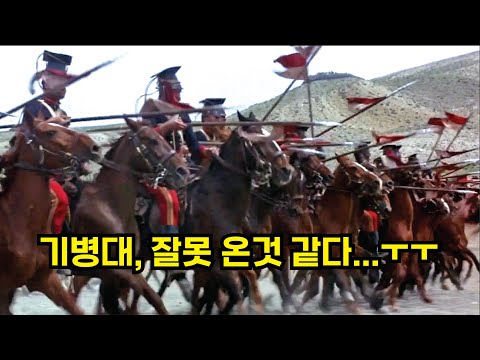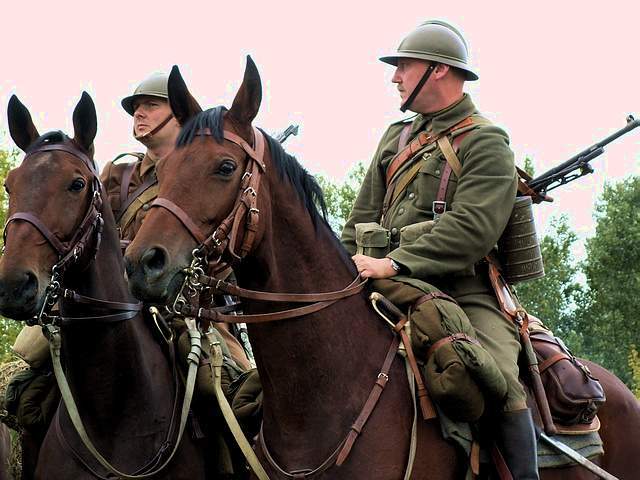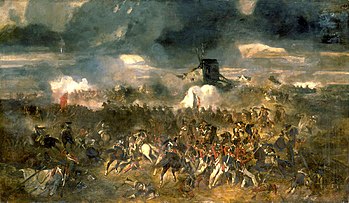기병 돌격
기병 돌격은 말을 타고 적의 위치로 가서 공격하는 전투 방식을 말한다. 이 방식은 전 세계의 군사 역사에서 중요한 역할을 하며, 특히 중국, 일본, 몽골, 페르시아, 터키 등에서 많이 사용되었다.
한국의 기병 돌격은 고구려와 발해 시대부터 시작되어 조선 시대에 이르러서도 유지되었다. 고구려 시대에는 왕족들이 자신의 활약을 고구려 국민들에게 보여주기 위해 행하는 시합인 날부리에서 그 뿌리를 찾을 수 있다. 또한 발해 시대에는 나란히 중하병과 함께 기병이 사용되고, 발해가 근주에서 길지를 향해 쳐들어갈 때도 기병이 중요한 역할을 했다.
조선 시대에는 서유견, 이이, 임진경 등 무신 임금들이 기병을 중시하였으며, 기병의 역할과 중요성이 점차 대두되었다. 특히건위훈련과 함께 조선 후기에는 기병 부대가 전투력을 갖추어 많은 전투에서 활약하였다.
기병 돌격의 전술적 특징과 효과
기병 돌격은 다음과 같은 전술적 특징을 가진다.
첫째, 빠른 이동성을 가진다. 말을 타고 이동하기 때문에 보병이나 기타 병종에 비해 빠르게 이동할 수 있다. 또한 기병은 적의 위협 범위를 빠르게 침투하여 적의 뒷장에서 공격할 수 있다.
둘째, 강력한 공격력을 발휘할 수 있다. 기병이 가지고 있는 압도적인 공격력은 보병과 비교할 때 더욱 강력하다. 빠른 이동성과 함께 기병이 적의 퇴각을 방해하고, 적의 부대를 쪼개어 공격할 수 있다.
셋째, 적의 심리적인 영향력을 가진다. 적에게 공격에 적당한 방어 태세나 위치를 제공하지 않으므로 적은 굉장한 심리적 압박을 받게 된다.
기병 돌격에 필요한 군인의 능력과 교육
기병 돌격은 말을 타고 전장에서 활약해야 하므로, 군인들은 말 타는 능력과 전투 방식을 숙지해야 한다. 또한 기병 돌격은 다수의 기병들이 동시에 공격해야 효과를 발휘하므로 기병 부대들 간의 조화와 유닛 훈련이 중요하다.
특히 기병 군인들은 말 탈 줄 알아야 하며, 말을 통제하고 조종하는 능력을 필수적으로 갖추어야 한다. 또한 정확한 활 실력과 칼 등의 무기 사용법도 중요하다.
기병 돌격이 사용되는 전장의 조건과 예시
기병 돌격은 평지, 계곡, 개척된 산지 등 다양한 전장에서 사용되었다. 평지에서는 기병이 빠른 이동력을 이용해 적의 거점을 빠르게 타격하거나, 계곡에서는 적이 움직이기 어려운 장소에서 쉽게 적을 공격할 수 있다.
한국사에서는 조선 시대에 일어난 치평야전이 기병 돌격의 전투 방식의 대표적인 예시 중 하나이다. 이 전투에서는 조선의 기병이 여러 차례 적진을 침투해 적의 후방 부대를 파괴하고, 전투의 결정적인 승리를 이끌어내었다.
기병 돌격의 활용 방법과 전략적 근거
기병 돌격은 다음과 같은 방법으로 활용된다.
첫째, 적 진형을 뚫고 적의 후방부대를 공격하는 방법이다. 기병이 빠른 이동력을 활용해 적의 전선을 뚫고 적의 후방으로 침투하여 공격하면, 적은 혼란에 빠지고 불안정해진다.
둘째, 적의 퇴각을 방해하기 위해 사용되는 방법이다. 기병 돌격이 주로 진행되는 전장에서 보유한 빠른 이동력과 공격력은 적이 후퇴하는 적에게 상당한 위협을 가한다.
셋째, 적의 전략적 취약점을 공격하는 방법이다. 이 방법은 기병이 적 왕국의 약점을 찾아내어 기습하는 전략을 말한다. 기병 부대가 약점을 공격하면, 적은 그들의 방어력을 쉽게 깨지며, 이를 통해 전술적인 승리를 가져갈 수 있다.
기병 돌격의 단점과 대안적 전투 방식에 대한 고찰
기병 돌격은 높은 이동력, 공격력, 심리적 압박 등의 이점이 있지만, 불리한 점도 있다.
첫째, 기병 자체가 적의 투사체에 대한 방어력이 매우 약하다. 또한 기병이 말을 타고 있기 때문에 발각될 가능성이 높다.
둘째, 기병은 대개 보병과 무기나 방어 장비 등의 굴레가 적다. 따라서 보병의 세세한 전투 상황에 대한 대응력이 상대적으로 약하다.
이러한 기병 돌격의 단점에 대한 보완책으로는 다음과 같은 대안적인 전투 방식이 제안되고 있다.
첫째, 보병과 기병, 그리고 각종 병종들이 모두 제 각각의 특성에 따라 그 소속을 확정하고 전략적으로 대응해야 한다.
둘째, 기병과 보병을 상호 보완하면서 전투하는 방법이 있다.
셋째, 지형 상황에 따라 다양한 병종이 조합되면서 전투하는 방법이 있다.
이러한 다양한 대안적 전투 방식을 활용하면서 실전상황에서 자신의 전략을 수정하면 좀 더 효과적인 공격을 할 수 있다.
FAQs
기병 약점은 무엇인가?
기병의 최대 약점은 이동하면서 보호가 쉽게 밀려나면서 분산되는 점이다. 그렇기 때문에 보병과 함께 활용해야 효과적인 전투가 가능하다.
보병 vs 기병, 기병 보병 무엇이 더 좋은가?
보병과 기병은 각각의 특성을 지니고 있기 때문에 상황과 전략에 따라 활용되어야 한다. 주로 밀접한 조합으로 사용하는 경우가 많다.
고려 기병은 어떤 역할을 했는가?
고려시대 기병은 당시 전투에서 중요한 역할을 맡았다. 이들은 말 타고 움직여 전쟁 거점으로 이동해 적의 계획을 공격하는 데 중심적인 역할을 했다.
기병 뜻은 무엇인가?
기병은 말을 타고 전장에서 활동하는 군대를 의미한다.
고구려 기병의 전투 방식은 어떤 것이 있나?
고구려 기병이 전장에서 활용했던 전투 방식에는 마상신과 같은 일본산 말을 사용하는 것이 있었다. 또한, 임진왜란 때와 같이 고구려 말을 사용하는 부대도 출전하였다.
기병 영어로는 무엇인가?
기병의 영어 표현은 ‘cavalry’ 이다.
삼국지 기병 돌격에 대한 이야기가 있다면?
삼국지 시대에는 군사 전술들이 발전을 이루었고, 기병 돌격도 유σ호, 손권, 관성, 조마, 준결 등의 여러 전술을 이용하면서 발전하였다. 권혁의 ‘서곡전기’와 ‘세명전기’ 등에서 이들 전술에 대한 이야기를 볼 수 있다.
사용자가 검색한 키워드: 기병 돌격 기병 약점, 보병 vs 기병, 기병 보병, 고려 기병, 기병 뜻, 고구려 기병, 기병 영어, 삼국지 기병
Categories: Top 60 기병 돌격
대포 앞으로 닥돌하던 가슴이 웅장해지는 환장의 그 기병대!!!
여기에서 자세히 보기: future-user.com
기병 약점
Origins of 기병 약점
The use of cavalry in Korean warfare traces back to ancient times, where horses were primarily used as a means of transportation for Korean aristocrats and warriors. However, it wasn’t until the 7th century that the Korean peninsula saw the emergence of formal cavalry units. The Silla Kingdom established the Cheonma-chong (Thousand Horse Unit), composed of skilled equestrians equipped with iron weapons and armor, marking the beginning of organized Korean cavalry.
With the establishment of cavalry units, Korean commanders quickly realized that horse-mounted soldiers were invaluable on the battlefield – they were faster, more agile, and could cover longer distances compared to infantry units. For centuries, Korean armies relied on their horses to outflank the enemy and wreak havoc behind enemy lines.
However, as with any type of warfare, cavalry had its weaknesses, and the Korean military was no exception. Understanding the vulnerabilities of mounted soldiers was crucial in determining the outcome of battles and minimizing losses.
The Anatomy of 기병 약점
기병 약점 encompasses several aspects of cavalry warfare, but the most significant vulnerabilities are:
1. The horse’s endurance
2. The rider’s standoff distance
3. The horse’s visibility
The horse’s endurance refers to its limitations in sustained physical activity. Horses are not machines – they require food, water, rest, and medical attention. Without careful management and planning, horses may tire and falter during prolonged battles or campaigns, rendering their riders helpless and vulnerable to the enemy’s assaults.
The rider’s standoff distance is the distance between the cavalry unit and the enemy. Unlike infantry units, cavalry relies on speed and maneuverability to maintain distance from the enemy. However, once engaged in combat, horses become uncontrollable and unpredictable, making it challenging for the rider to maintain the desired distance. Moreover, horses are susceptible to fear and panic, making them prone to charge towards the enemy, exposing their riders to close-range attacks and throwing the unit’s formation into disarray.
The horse’s visibility refers to its inability to see incoming attacks from its blind spots. Horses have a limited field of vision, and their riders must compensate by being alert and vigilant at all times. However, even the most experienced and attentive rider may miss hidden threats, such as hidden traps, ambushes, and terrain obstacles, putting the entire unit at risk.
Strategies of 기병 약점
To mitigate the risks associated with 기병 약점, Korean commanders developed several strategies and tactics, including:
1. Hit-and-run attacks
2. Flanking maneuvers
3. Faking retreats
4. Camouflage and deception
Hit-and-run attacks involved charging into the enemy’s flank or rear, delivering a swift and devastating blow, and retreating before the enemy could respond effectively. This strategy relied heavily on speed and surprise, exploiting the enemy’s unpreparedness and lack of coordination.
Flanking maneuvers were designed to outflank the enemy’s formations, creating confusion and chaos in their ranks. This strategy relied on superior mobility and maneuverability, allowing Korean cavalry units to take advantage of the enemy’s weaker flank or rear.
Faking retreats involved feigning defeat and pulling back, luring the enemy into a false sense of security and letting them chase after the retreating unit. Once the enemy had overcommitted, the Korean cavalry would turn around and launch a surprise attack, catching the enemy off-guard and demoralizing their forces.
Camouflage and deception involved hiding the cavalry unit’s presence or disguising it as another unit. This strategy aimed to confuse the enemy and create an opportunity for surprise attacks, infiltration, or espionage.
FAQs on 기병 약점
Q: Was 기병 약점 unique to Korean cavalry warfare, or did other cavalry units face similar weaknesses?
A: 기병 약점 is a universal concept in cavalry warfare, as all mounted soldiers face similar limitations and vulnerabilities. However, each culture and region had its unique approach to mitigating the risks associated with cavalry warfare.
Q: Did Korean cavalry play a significant role in Korea’s history?
A: Yes, Korean cavalry played a critical role in Korea’s history, from the ancient Three Kingdoms period to the late Joseon dynasty. Korean cavalry units were instrumental in defending the border against foreign invasions, suppressing rebellions, and conducting recon operations.
Q: Is 기병 약점 relevant in modern warfare?
A: While modern warfare does not rely on cavalry units as they did in the past, the concept of 기병 약점 remains relevant, as many of its principles apply to modern combat as well. For instance, the vulnerabilities of mounted soldiers are similar to those of armored vehicles, which require logistical support, have limited visibility capabilities, and are susceptible to ambushes and IEDs.
In conclusion, 기병 약점 is an essential concept in understanding Korean cavalry warfare, its tactics, and limitations. While Korean cavalry units were renowned for their speed, maneuverability, and strategic value, they also had vulnerabilities that required careful management and planning. Understanding 기병 약점 helps us appreciate the ingenuity and bravery of Korean cavalry soldiers and their commanders, who faced tremendous challenges on the battlefield and overcame them through cunning and courage.
보병 vs 기병
If you are a military enthusiast or someone who is interested in Korean military history, then this article is for you. We are going to dive deep into the heart of the Korean army, explore the differences between the infantry and cavalry, and bust some myths that are popular in the Korean military.
Differences between 보병 (Infantry) and 기병 (Cavalry)
The difference between the Korean infantry and cavalry cannot be overemphasized. The infantry, which is known as 보병, is the foot soldiers of the Korean army. They undertake a range of military operations that include reconnaissance, clearing enemy strongholds, and attacking enemy positions. The infantry is considered as the backbone of the Korean army. They are equipped with the latest technology and weaponry, ensuring that they carry out their missions seamlessly.
On the other hand, the Korean cavalry, which is known as 기병, is the mounted troops of the Korean army. They are trained to provide mobility and speed to the army. The cavalry has existed in the Korean army since the ancient times and has played an important role in securing the homeland.
The cavalry is equipped with horses and advanced technology to help them carry out their tasks efficiently. They are responsible for carrying out reconnaissance missions, patrolling the borders, and providing support to the infantry. The cavalry is specially trained to be agile and adapt to the terrain, making them very effective in their roles.
One of the most pronounced differences between the infantry and cavalry is the type of equipment they use. In the Korean army, the infantry is equipped with rifles, hand grenades, and pistols. They are also equipped with supporting weapons, such as machine guns and anti-tank guns. The cavalry, on the other hand, is equipped with rifles, pistols, and other weapons suitable for mounted troops. They also have artillery and anti-tank weapons that can be easily transported with the help of their horses.
Another difference between the infantry and cavalry is their training. Infantry training is based on foot movement, agility, and endurance. They also undergo training in using various weapons and tactics to achieve their objectives. Cavalry training is based on horse-riding, taking care of the horse, and using weapons suitable for mounted troops.
Similarly, the uniforms of the infantry and cavalry are also distinct. The infantry is equipped with green-colored uniforms, while the cavalry is equipped with a brown-colored uniform – reflecting the historical roots of the cavalry. The cavalry’s uniform also features a high collar and knee-length boots, which make it easier for them to ride horses.
Some myths about the Korean infantry and cavalry
There are some myths surrounding the Korean infantry and cavalry that are popular among the Korean people. Let’s bust some of these myths.
Myth 1: The cavalry is more important than the infantry
The truth is, both the infantry and cavalry are important for the Korean army. They both play crucial roles in securing the homeland. While the infantry is the backbone of the Korean army, the cavalry ensures mobility, speed, and reconnaissance. Together, they ensure that the Korean army can tackle any security challenge it faces.
Myth 2: The cavalry is more elite than the infantry
The truth is, both the infantry and cavalry are elite in their own right. The infantry is trained to be agile, resilient, and lethal. They use advanced weaponry and tactics to carry out their tasks efficiently. The cavalry, on the other hand, is trained to be very mobile, adaptable, and quick. They play an important role in reconnaissance and provide support to the infantry when needed.
Myth 3: The infantry is less equipped than the cavalry
The truth is, both the infantry and cavalry are equipped with the latest technology and weaponry. The infantry is equipped with rifles, machine guns, anti-tank weapons, and hand grenades. The cavalry is equipped with rifles, pistols, and other weapons suitable for mounted troops. They also have artillery and anti-tank weapons that can be easily transported with the help of their horses.
FAQs
Q: Which is more difficult – infantry or cavalry training?
Both the infantry and cavalry training are difficult and require a lot of dedication and hard work. Infantry training is based on foot movement, agility, and endurance. Cavalry training is based on horse-riding, taking care of the horse, and using weapons suitable for mounted troops.
Q: Can the cavalry operate without horses?
No. The cavalry is specifically trained to operate on horseback. The horse provides mobility and speed, making the cavalry very effective in their tasks.
Q: How do you join the Korean infantry or cavalry?
To join the Korean army, you must be a Korean citizen, aged between 18 and 28 years. You must also meet the physical requirements and undergo rigorous training. To join the infantry or cavalry, you must meet the specific requirements for each unit.
Conclusion
The Korean army is a formidable stronghold in the Asian continent and is known for its discipline, training, and equipment. The infantry and cavalry are an integral part of the Korean army and have their specifics, challenges, and characteristics. The infantry is responsible for a range of military operations, while the cavalry provides mobility and speed. Both play crucial roles in securing the homeland, and both require rigorous training and dedication. So, whether you are interested in military history or just curious about the Korean army, it is important to understand the differences between the infantry and cavalry.
주제와 관련된 이미지 기병 돌격

기병 돌격 주제와 관련된 이미지 23개를 찾았습니다.

![나폴레옹 시대의 미친 기병대 지휘관 돌격 전술 [토탈워 멀티] - YouTube 나폴레옹 시대의 미친 기병대 지휘관 돌격 전술 [토탈워 멀티] - Youtube](https://i.ytimg.com/vi/1gvKG8hs6-Q/maxresdefault.jpg)


![삼탈워] 속이 후련해지는 기병뽕 돌격-인간뽈링핀 - YouTube 삼탈워] 속이 후련해지는 기병뽕 돌격-인간뽈링핀 - Youtube](https://i.ytimg.com/vi/m2m-LL_IzMI/maxresdefault.jpg)

![Battle of the Pyramids [ NTW Multiplayer Battle ] - YouTube Battle Of The Pyramids [ Ntw Multiplayer Battle ] - Youtube](https://i.ytimg.com/vi/mwpD-VpGCwI/maxresdefault.jpg)
![중세시대 기병돌격 [마운트앤블레이드2 배너로드] - YouTube 중세시대 기병돌격 [마운트앤블레이드2 배너로드] - Youtube](https://i.ytimg.com/vi/9wwTp9n6EPE/maxresdefault.jpg)












Article link: 기병 돌격.
주제에 대해 자세히 알아보기 기병 돌격.
- 근/현대전사의 기병 돌격들 몇가지.
- 기병 돌격 전술의 쇠퇴와 기병 개혁의 실패 – 한국학술지인용색인
- 기병 – 위키백과, 우리 모두의 백과사전
- #2 전차와 맞선 기병대의 신화 | 가우디의 역사 이야기
- 드래곤을 친구로 만드는 법 5 – Kết quả Tìm kiếm Sách của Google
- 삼국지 유봉전 : 계한의 부흥 17권 – Kết quả Tìm kiếm Sách của Google
- 리페어 7 (완결) – Kết quả Tìm kiếm Sách của Google
더보기: future-user.com/wki